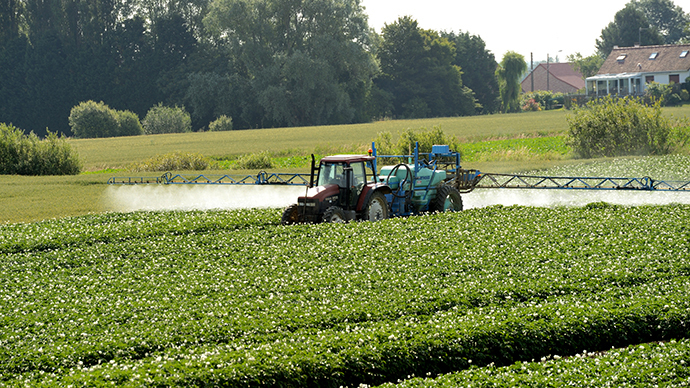Neurotoxic pesticides blamed for the decline of honeybees is also harming butterflies, worms, fish, and birds, and contaminating habitats worldwide which are crucial for food production and wildlife, scientists have concluded after a four-year assessment.
Societal regulations have not stopped habitats from being poisoned, said the analysis, despite neurotoxic pesticides already being held responsible for the global collapse in the bee population.
"Undertaking a full analysis of all the available literature (800 peer reviewed reports) the Task Force on Systemic Pesticides - a group of global, independent scientists has found that there is "clear evidence of harm sufficient to trigger regulatory action," a press release accompanying the report noted.
Twenty-nine scientists from four different continents conducted the study, which found the unmistakable evidence of the link.
"I think the only acceptable dose of this systemic pesticide is just nothing - zero," said Dr. Jean Marc Bonmatin, a researcher at CNRS-CBM lab in France. "We are able, in this laboratory, to detect very, very small amounts of these neurotoxins. And as toxicologists, we are able to test these toxicants on drosophila - on bees - and so on. So we are able to see the effect of such tiny amounts of neurotoxins."
The pesticides referred to in the report are neonicotinoids (neonics) and fipronil. Farmers spend some US$2.6 billion on neonicotinoids worldwide every year. They are used as a general practice rather than a response to a pest problem.
"The majority of the pesticide doesn't go into the crop at all," said Professor Dave Goulson from the UK's University of Sussex, who contributed to the study. "More than 90 percent of it goes elsewhere into the environment and they're really persistent in the environment."
Goulson said that cumulatively, we as humans are "contaminating the global environment with highly toxic, highly persistent chemicals."
"If all our soils are toxic, that should really worry us, as soil is crucial to food production," he added.
Butterflies, bees, birds suffering...humans next?
In Marinduque, a province of the Philippines, the rural population practices butterfly farming to encourage the sustained pollination growth of local vegetation. "All the people here in the rural areas depend on the butterflies, and continued use of pesticides could destroy their livelihood," said Elizabeth Lumawig-Heitzmann, director of Romeo Lumawig Memorial Museum.
In addition to butterflies, maintaining bee and insect populations are necessary for the pollination of crops. "These days many people are completely detached from nature - they buy their food in a supermarket, they live in a city...biodiversity is vitally important for us," said Bonmatin.
Bees are affected because chemicals hurt their ability to both navigate and learn. Neonics can be 5,000 to 10,000 times more toxic to bees than DDT - which itself has been banned in agriculture.
"The classic measurements used to assess the toxicity of a pesticide (short‐term lab toxicity results) are not effective for systemic pesticides and conceal their true impact. They typically only measure direct acute effects rather than chronic effects via multiple routes of exposure," the report found.
However, bees are not the only ones affected by the pesticides; birds and mammals which feed on the insects, as well as worms, are also harmed. Worms aerate soil, and chemicals can disrupt their ability to tunnel properly.
Because birds eat insects and worms, declines in their populations can also lead to a loss in the birds feeding on them. The report also postulates that even eating only a few contaminated seeds may kill birds directly.
Insecticides and pesticides seep into rivers and streams from the fields they are used on. "Microbes, fish and amphibians were found to be affected after high levels of or prolonged exposure," the report said.
"Overall, a compelling body of evidence has accumulated that clearly demonstrates that the wide-scale use of these persistent, water-soluble chemicals is having widespread, chronic impacts upon global biodiversity and is likely to be having major negative effects on ecosystem services such as pollination that are vital to food security," the study concluded.The report is part of a special edition of thepeer-reviewed journal 'Environmental Science and Pollution Research.'
The EU has already placed a three-year ban on using three neonicotinoids (clothianidin, imidacloprid, and thiametoxam) on flowering crops which bees feed on. However, they can still be used on winter crops.
Pesticide manufacturers were critical of the study's findings. "It is a selective review of existing studies which highlighted worst-case scenarios, largely produced under laboratory conditions," said Nick von Westenholz, chief executive of the Crop Protection Association, before reiterating the need to "protect pollinator health."
According to Goulson, the focus has so far only been on honeybees. "It's clear that the impacts of neonics are more profound than that," he said, adding that the story stretches beyond bees "to all wildlife that lives on farmland."




I find it obvious that any significant amount of a toxic substance released in the environment is likely, in some way, going to affect a whole bunch of plants, microbes, bugs, and animals... and people.
Still, I respect the scientists for their work because common sense makes more of an impact when backed up by evidence and being able to provide solid facts that can't be disputed to the public is a (the?) smart way to raise awareness.